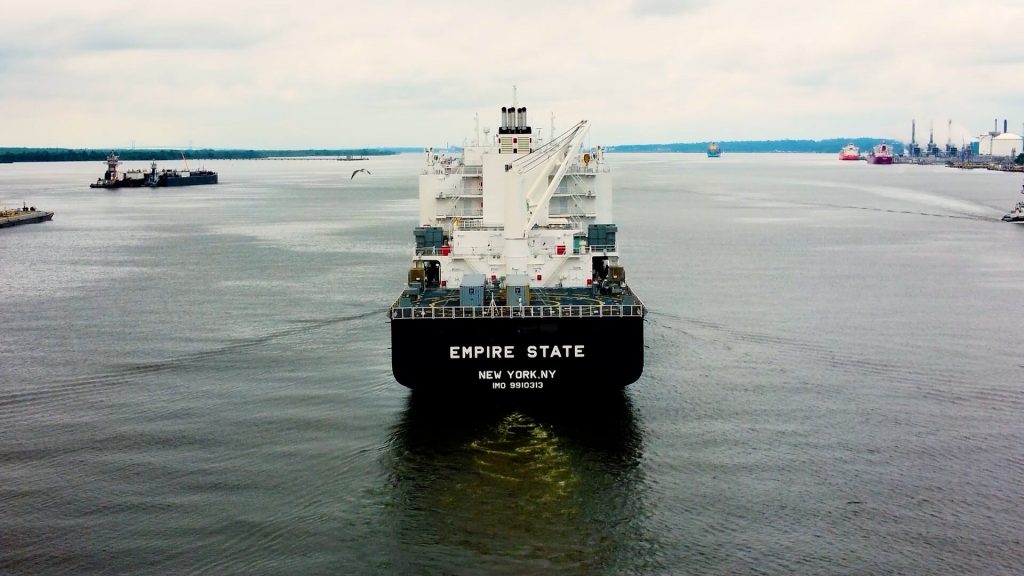China’s building 1,700 ships to America’s 5. Senators say it’s a security issue

China, Japan and South Korea are dominating the commercial shipbuilding industry to such an extent that it’s considered a national security issue for the United States. In what can be described as a future war effort, Sens. Todd Young, R-Ind., and Mark Kelly, D-Ariz., want to reinvigorate American shipyards that sank generations ago and never recovered.
The lawmakers introduced the SHIPS for America Act. The bill has two main objectives: build 250 ocean-going vessels in the United States over the next 10 years and train the mariners and tradesmen necessary to operate, build and maintain the vessels.
The stakes are high. As Young explained to Straight Arrow News, their goals are ambitious, and the United States can’t fail.
“We took our eye off the ball. Other countries had prioritized shipbuilding for domestic political reasons, but more importantly, for national security reasons,” Young told SAN. “They rightly understood that shipbuilding has national security spillover implications, and it’s really important for a country to have shipbuilding capacity.”
For context, China currently builds 1,700 ocean-going vessels per year. The United States builds five. China, along with Japan and South Korea, dominates the industry, with 90% of all new ocean-going vessels.
“You will not have a cost-effective and on-time naval shipbuilding enterprise if you do not have a strong commercial shipbuilding enterprise,” Michael Viggiano, director of government affairs for Hanwha USA, said.
An ocean-going vessel is a large ship capable of crossing the open ocean. They include container ships, bulk carriers, general cargo ships, passenger ships, oil tankers and vehicle carriers.
A timeline of America’s shipbuilding decline
America was the envy of the world after World War II. The United States had more than 4,400 flagged ships of all types and sizes capable of carrying 57% of U.S. trade.
After the war, the government sold many of those surplus vessels to shipping companies at great prices. That, combined with higher labor costs in the states, dried up demand for new American ships, and the yards closed.
By the 1970s, the United States was only building 15 to 25 new commercial ships per year. That dropped to five by the 80s, and it’s where the country remains today.
American shipbuilding today
There are only six shipyards in the United States building large commercial vessels, which include Philly Shipyard, owned by Hanwha.
The South Korea-based company supports the SHIPS for America Act and its goal of unlocking public funding to build new shipyards and revive some of the 60 shipyards that have fallen out of service. As Viggiano explained, a private shipyard has not been stood up in the United States without significant government assistance since the 19th century.
“If we are standing up new shipyards in the United States, it’s going to have to involve U.S. government support,” Viggiano said.
Viggiano pointed to World War II as an example of what America is capable of. The U.S. built six emergency shipyards in six months. “So we can do it. It’s a doable feat,” Viggiano explained. “Is shipbuilding more complicated than it was then? Yes. Are ships more complicated? Yes. But if you have the funding available, it’s possible.”
Due to low demand, Philly Shipyard currently builds 1.2 ships per year. In an industry with tight margins, scaling up can have compounding effects. “I’ll make it simple math. If at Philadelphia you build 1.2 ships a year, any (capital expenditure) you make, your labor costs, they’re spread off 1.2 ships a year,” Viggiano said.
He compared that to Hanwha’s shipyards in South Korea, which build 35 to 50 ships per year.
“Now my CapEx investment is amortized out across those number of ships. The profit, my labor costs, which are not linear, are now spread out over 40 ships instead of 1.2,” Viggiano said. “And it’s not like 40 ships takes 40 times the labor of one ship. You’re benefiting significantly.”
How would the SHIPS for America Act help?
The 310-page bill is a comprehensive overhaul of the American maritime industry.
These are some of the key provisions:
- Create a Maritime Security Trust Fund, very similar to the Highway and Aviation Trust Funds. That money would be used to help shipyards and shipbuilding.
- Create a program to establish a fleet of 250 U.S.-flagged vessels in international commerce.
- Establish tax and import duty incentives for shipping goods into the U.S. on American ships.
- Create incentives for Americans to pursue a career as a mariner, such as public service loan forgiveness.
“This is a national security bill. It’s also a bill about economic security and economic opportunity and making sure that we’re independent of other countries for essential services like shipping,” Young said. “But more than anything else, this is a national security bill.”
Why does commercial shipbuilding matter to national security?
Shipbuilding is integral to national security for two main reasons: sealifts and efficiency.
If the United States ever went to war, it would need a sealift, when troops, weapons, vehicles and supplies are sent to the war zone on a combination of military and commercial vessels.
It’s an essential part of war logistics because sealifts can carry substantially heavier payloads than airlifts. In fact, cargo ships could transport 90% of the military equipment needed overseas.
Young told Straight Arrow News that if the United States entered a military conflict lasting more than a few months, we would not be able to repair and build new vessels. “Right now we don’t have that capacity,” Young said. “That ought to be alarming to every American.”
The other reason is cost and efficiency.
As Viggiano explained, if shipbuilders and their parts suppliers have a diverse stream of customers, prices will come down. He gave the example of a widget that is built for Naval vessels.
“If that widget only goes into a naval ship, the amount of premium the U.S. government has to pay to keep me in business to exclusively supply that widget for the naval ship is much higher than if my widget goes into the naval ship and goes into these three classes of commercial ship,” Viggiano said. “I have other lines of business that allow me then to price my product appropriately to the Navy because they’re not the sole reason I exist.”
A years-long, national commitment
The bill is still in the early stages of becoming a law. But even if it were approved and signed tomorrow, it would take years and a government investment of hundreds of millions of dollars to get the industry to where the senators know it can be.
The post China’s building 1,700 ships to America’s 5. Senators say it’s a security issue appeared first on Straight Arrow News.





